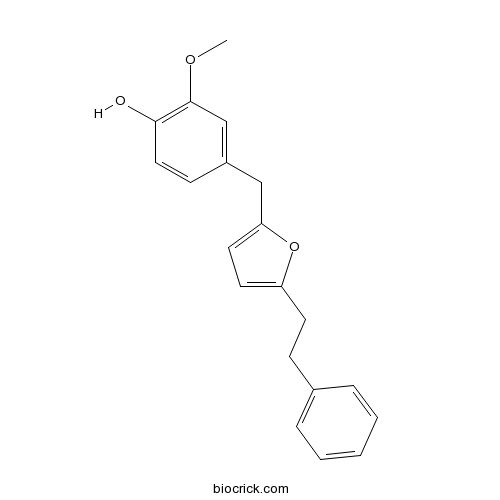Alpinoid DCAS# 1041740-13-9 |

Quality Control & MSDS
3D structure
Package In Stock
Number of papers citing our products

| Cas No. | 1041740-13-9 | SDF | Download SDF |
| PubChem ID | 38363343 | Appearance | Powder |
| Formula | C20H20O3 | M.Wt | 308.4 |
| Type of Compound | Phenols | Storage | Desiccate at -20°C |
| Solubility | Soluble in Chloroform,Dichloromethane,Ethyl Acetate,DMSO,Acetone,etc. | ||
| Chemical Name | 2-methoxy-4-[[5-(2-phenylethyl)furan-2-yl]methyl]phenol | ||
| SMILES | COC1=C(C=CC(=C1)CC2=CC=C(O2)CCC3=CC=CC=C3)O | ||
| Standard InChIKey | FQYPVFASDPWNIJ-UHFFFAOYSA-N | ||
| General tips | For obtaining a higher solubility , please warm the tube at 37 ℃ and shake it in the ultrasonic bath for a while.Stock solution can be stored below -20℃ for several months. We recommend that you prepare and use the solution on the same day. However, if the test schedule requires, the stock solutions can be prepared in advance, and the stock solution must be sealed and stored below -20℃. In general, the stock solution can be kept for several months. Before use, we recommend that you leave the vial at room temperature for at least an hour before opening it. |
||
| About Packaging | 1. The packaging of the product may be reversed during transportation, cause the high purity compounds to adhere to the neck or cap of the vial.Take the vail out of its packaging and shake gently until the compounds fall to the bottom of the vial. 2. For liquid products, please centrifuge at 500xg to gather the liquid to the bottom of the vial. 3. Try to avoid loss or contamination during the experiment. |
||
| Shipping Condition | Packaging according to customer requirements(5mg, 10mg, 20mg and more). Ship via FedEx, DHL, UPS, EMS or other couriers with RT, or blue ice upon request. | ||
| Description | Standard reference |
| In vitro | New cytotoxic diarylheptanoids from the rhizomes of Alpinia officinarum.[Pubmed: 18484537]Planta Med. 2008 Mar;74(4):427-31.
|

Alpinoid D Dilution Calculator

Alpinoid D Molarity Calculator
| 1 mg | 5 mg | 10 mg | 20 mg | 25 mg | |
| 1 mM | 3.2425 mL | 16.2127 mL | 32.4254 mL | 64.8508 mL | 81.0636 mL |
| 5 mM | 0.6485 mL | 3.2425 mL | 6.4851 mL | 12.9702 mL | 16.2127 mL |
| 10 mM | 0.3243 mL | 1.6213 mL | 3.2425 mL | 6.4851 mL | 8.1064 mL |
| 50 mM | 0.0649 mL | 0.3243 mL | 0.6485 mL | 1.297 mL | 1.6213 mL |
| 100 mM | 0.0324 mL | 0.1621 mL | 0.3243 mL | 0.6485 mL | 0.8106 mL |
| * Note: If you are in the process of experiment, it's necessary to make the dilution ratios of the samples. The dilution data above is only for reference. Normally, it's can get a better solubility within lower of Concentrations. | |||||

Calcutta University

University of Minnesota

University of Maryland School of Medicine

University of Illinois at Chicago

The Ohio State University

University of Zurich

Harvard University

Colorado State University

Auburn University

Yale University

Worcester Polytechnic Institute

Washington State University

Stanford University

University of Leipzig

Universidade da Beira Interior

The Institute of Cancer Research

Heidelberg University

University of Amsterdam

University of Auckland

TsingHua University

The University of Michigan

Miami University

DRURY University

Jilin University

Fudan University

Wuhan University

Sun Yat-sen University

Universite de Paris

Deemed University

Auckland University

The University of Tokyo

Korea University
- MitoPY1
Catalog No.:BCC6177
CAS No.:1041634-69-8
- Kuguaglycoside C
Catalog No.:BCN3276
CAS No.:1041631-93-9
- Peramivir Trihydrate
Catalog No.:BCC4956
CAS No.:1041434-82-5
- Eldecalcitol
Catalog No.:BCC1548
CAS No.:104121-92-8
- Phellodendrine chloride
Catalog No.:BCN5934
CAS No.:104112-82-5
- Kadsuric acid 3-methylester
Catalog No.:BCN3186
CAS No.:1041070-16-9
- SR 95531 hydrobromide
Catalog No.:BCC6997
CAS No.:104104-50-9
- Fmoc-D-Glu(OtBu)-OH
Catalog No.:BCC3496
CAS No.:104091-08-9
- Zolantidine dimaleate
Catalog No.:BCC6922
CAS No.:104076-39-3
- Atipamezole hydrochloride
Catalog No.:BCC7521
CAS No.:104075-48-1
- Cyclo(Ile-Val)
Catalog No.:BCN2410
CAS No.:104068-43-1
- Rehmapicroside
Catalog No.:BCN2884
CAS No.:104056-82-8
- Stanozolol
Catalog No.:BCC9154
CAS No.:10418-03-8
- 10-Nitro-camptothecin
Catalog No.:BCN2581
CAS No.:104195-61-1
- Estriol 3,17-dihexanoate
Catalog No.:BCN2238
CAS No.:104202-96-2
- Yunnandaphninine G
Catalog No.:BCN5857
CAS No.:1042143-83-8
- IRAK inhibitor 1
Catalog No.:BCC1654
CAS No.:1042224-63-4
- Famciclovir
Catalog No.:BCC4780
CAS No.:104227-87-4
- IRAK inhibitor 6
Catalog No.:BCC1658
CAS No.:1042672-97-8
- Bisoprolol fumarate
Catalog No.:BCC4344
CAS No.:104344-23-2
- Tetrahydroxysqualene
Catalog No.:BCN5858
CAS No.:1043629-23-7
- RU-SKI 43
Catalog No.:BCC5441
CAS No.:1043797-53-0
- L803-mts
Catalog No.:BCC5889
CAS No.:1043881-55-5
- Typhaneoside
Catalog No.:BCN4994
CAS No.:104472-68-6
New cytotoxic diarylheptanoids from the rhizomes of Alpinia officinarum.[Pubmed:18484537]
Planta Med. 2008 Mar;74(4):427-31.
Bioassay-guided fractionation of the cytotoxic MeOH extract from the rhizomes of Alpinia officinarum Hance led to the isolation of two new diarylheptanoids named Alpinoid D (1) and E (2), together with fifteen known diarylheptanoids (3 - 17). The structures of compounds 1 and 2 were elucidated on the basis of spectroscopic data and chemical evidence. The cytotoxic activity of the isolated diarylheptanoids was evaluated against the IMR-32 human neuroblastoma cell line. Among the tested compounds, 11, 12 and 14 exhibited the most potent activities with IC (50) values of 0.83, 0.23 and 0.11 microM, respectively.


